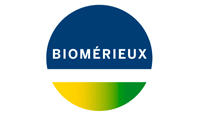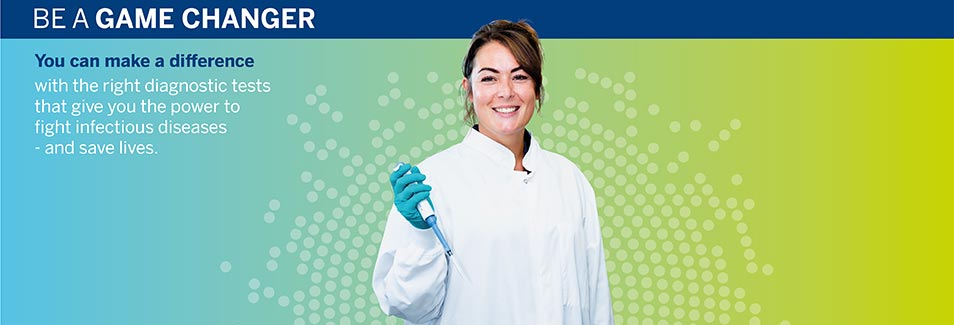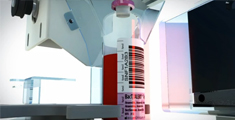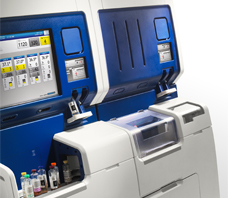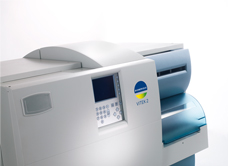Haben Sie sich jemals gefragt, was ein Gerät für die mikrobiologische Diagnostik effizient macht? Effizienz wird durch eine flexible, ergonomische Geräte-Konzeption und eine Software erreicht, die eine effektive Prozesskontrolle und optimalen Informationsfluss ermöglicht – und das alles mit minimalem Benutzereingriff.
Diese Grundsätze waren die treibende Kraft für das neueste Software-Update für unser VITEK® 2System zur automatisierten Identifizierung und Empfindlichkeitsprüfung (ID and AST). Im Markt ist VITEK® 2 als effizientestes ID and AST-System anerkannt. Es liefert automatisierte, standardisierte, taggleiche Ergebnisse1-6 und erfordert im Labor die niedrigste Personalbindung2,7-11.
Mit der neuen VITEK® 2 Systems 8.01 Software (Verfügbar ab Sommer 2017) sind die Anwender in der Lage, das System noch effektiver zu nutzen. Die intuitive, sichere, webbasierte und konfigurierbare Software unterstützt einen reibungslosen Labor-Workflow mit Multi-User-Zugriff von praktisch überall und jederzeit. Nutzen Sie das Software-Update als Anlass, Ihre Laborabläufe zu überprüfen und eine effizientere und schnellere Probenbearbeitung fördern. Die VITEK® 2 Systems 8.01 Software ermöglicht dem Benutzer:
- Ansatz von ID und AST-Karten mittels Fernzugriff von jedem internetfähigen Computer ohne die Smart Carrier Station
- Gleichzeitiges, flexibles Einrichten mehrerer Carrier,
- Überprüfung und Bestätigung der Isolate und Patienteninformation von jedem internetfähigen PC
Die VITEK® 2 Systems 8.01 Software umfasst viele aktualisierte EUCAST– und CLSI-Grenzwerte. Außerdem wurden fünfzehn neue IDs für Mikroorganismen (Tabelle 1) in dieses Update aufgenommen.
Darüber hinaus ermöglicht die VITEK® 2 Systems 8.01 Software die Verwendung von Karten, welche die neue Antibiotika-Kombination Ceftolozan/Tazobactam enthalten (Zeitpunkt der Verfügbarkeit von Karten mit Ceftolozan/Tazobactam abhängig vom Verlauf derzeit stattfindenden, klinischen Performance-Studien). Dies ermöglicht die Bestimmung der Antibiotikaempfindlichkeit von gramnegativen aerobenBakterien wie Enterobacteriaceae und P. aeruginosa gegenüber Ceftolozan/Tazobactamund liefert Informationen für eine angemessene Behandlung mit Zerbaxa® von Merck.
Bitte nehmen Sie Kontakt mit Ihrer regionalen bioMérieux-Vertretung auf, um einen Zeitrahmen für ein Update der VITEK® 2 Systems 8.01 Software festzulegen.
Tabelle1: Mit VITEK® 2 Systems 8.01 neu verfügbare Mikroorganismen in der ID Datenbank
| GN | GP |
| Hafnia paralvei | Streptococcus iniae |
| Tatumella ptyseos | Listeria rocourtiae |
| Ralstonia insidiosa | Listeria fleischmannii |
| Pandoraea spp |
| NH | YST |
| Riemerella anatipestifer | Cryptococcus gattii |
| Histophilus somni | Zygosaccharomyces spp |
| Actinobacillus pleuropneumoniae | Candida auris |
| Actinobacillus suis | Candida duobushaemulonii |
| Moraxella (Neisseria) ovis | Candida haemulonii var vulnera |
| Neisseria weaveri |
Referenzen
-
Barry J., Brown A., Ensor V., Lakhani U., Petts D., Warren C., Winstanley T. Comparative evaluation of the VITEK® 2 Advanced Expert System (AES) in five UK hospitals. Journal of Antimicrobial Chemotherapy, 2003; 51: 1191–1202.
-
Blondel-Hill E., Jang W., Lee I., Borton N., Book L., Thomas E. Comparison of Phoenix™ and VITEK® 2 Compact for Performance of Identification and Susceptibility Testing, Workflow, and Time to Report. ICAAC 2006; Poster D-691.
-
Barenfanger J., et. al. J Clin Microbiol, 1999; 37(5): 1415
-
Galar A., Yuste J.R., Espinosa M., Guillén-Grima F., Hernáez-Crespo S., and Leiva J. Clinical and economic impact of rapid reporting of bacterial identification and antimicrobial susceptibility results of the most frequently processed specimen types. Eur J Clin Microbiol Infect Dis, 2012; 31 (9): 2445-2452.
-
Galar A., et. al. J Infect, 2012; 65(4):302
-
LaBombardi V.J. Maximizing the Use of the Advanced Expert System™ to Improve Patient Care. bioMerieux White Paper, 2011.
-
Ayats J., Cisnal M., Lucena J., and Marin R. Analysis of the Impact of Using a VITEK® 2 COMPACT System in a Clinical Microbiology Laboratory: Comparison with the MicroScan WalkAway System®. ASM 2007; Poster C-158.
-
Eigner U., Schmid A., Wild U., Bertsch D., Fahr A.M. Analysis of the Comparative Workflow and Performance Characteristics of the VITEK 2 and Phoenix Systems. Journal of Clinical Microbiology, 2005; 43(8): 3829–3834.
-
Heller-Ono A. Ergonomic Analysis Comparison of the VITEK® 2 and VITEK® 2 Compact with the Microscan WalkAway® 96 and Phoenix™ For Work Flow Efficiency and the Likelihood of Distal Upper Extremity Strain. bioMerieux White Paper, 2008.
-
Hooper M., Hill C., Hadwell V., Blondel-Hill E. Comparison of bioMerieux VITEK® 2 XL, BD Phoenix, and Seimens MicroScan Walkaway96 plus choosing an identification and antimicrobial susceptibility testing system for a medium sized microbiology laboratory. ECCMID 2013; Poster P-1536.
-
Römmler W., Beer L., Kessler M., and Kaehler K. Analysis of the Comparative Workflow and ID/ AST Test Result Accuracy of the VITEK® 2 compact and the Phoenix™ Systems. ASM 2006; Poster C-123.









